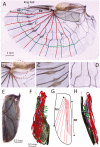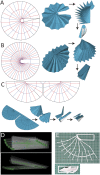Earwig fan designing: Biomimetic and evolutionary biology applications
- PMID: 32661166
- PMCID: PMC7395548
- DOI: 10.1073/pnas.2005769117
Earwig fan designing: Biomimetic and evolutionary biology applications
Abstract
Technologies to fold structures into compact shapes are required in multiple engineering applications. Earwigs (Dermaptera) fold their fanlike hind wings in a unique, highly sophisticated manner, granting them the most compact wing storage among all insects. The structural and material composition, in-flight reinforcement mechanisms, and bistable property of earwig wings have been previously studied. However, the geometrical rules required to reproduce their complex crease patterns have remained uncertain. Here we show the method to design an earwig-inspired fan by considering the flat foldability in the origami model, as informed by X-ray microcomputed tomography imaging. As our dedicated designing software shows, the earwig fan can be customized into artificial deployable structures of different sizes and configurations for use in architecture, aerospace, mechanical engineering, and daily use items. Moreover, the proposed method is able to reconstruct the wing-folding mechanism of an ancient earwig relative, the 280-million-year-old Protelytron permianum This allows us to propose evolutionary patterns that explain how extant earwigs acquired their wing-folding mechanism and to project hypothetical, extinct transitional forms. Our findings can be used as the basic design guidelines in biomimetic research for harnessing the excellent engineering properties of earwig wings, and demonstrate how a geometrical designing method can reveal morphofunctional evolutionary constraints and predict plausible biological disparity in deep time.
Keywords: aerospace engineering; biomimetics; deployable structure; dermaptera; origami.
Copyright © 2020 the Author(s). Published by PNAS.
Conflict of interest statement
The authors declare no competing interest.
Figures





References
-
- Prokop J., Nel A., Hoch I., Discovery of the oldest known Pterygota in the Lower Carboniferous of the Upper Silesian Basin in the Czech Republic (Insecta: Archaeorthoptera). Geobios 38, 383–387 (2005).
-
- Haas F., Gorb S., Wootton R. J., Elastic joints in dermapteran hind wings: Materials and wing folding. Arthropod Struct. Dev. 29, 137–146 (2000). - PubMed
-
- Eisner T., Defense mechanisms of arthropods. II. The chemical and mechanical weapons of an earwig. Psyche 67, 62–70 (1960).
-
- Ammar E.-D., Farrag S. M., Studies on the behaviour and biology of the earwig Labidura riparia Pallas (Derm., Labiduridae). Z. Angew. Entomol. 75, 189–196 (1974).
Publication types
LinkOut - more resources
Full Text Sources
Research Materials

